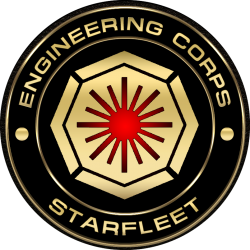Engineering
From Star Trek: Theurgy Wiki
On any starship, the department of Engineering was assigned to monitor and maintain the starship's functionality. Engineers often did most of the "grunt work" that was involved in keeping a ship or space station up and running. Engineering officers were generally assigned tasks that included maintaining and/or improving the performance of the warp drive, ship's database, computer processors and circuitry, holographic emitters, tractor beams, transporter components, observational equipment (such as sensors, probes, and satellites), weaponry systems, deflector array, hull plating, life support, shields and alternative defense systems, and many other crucial parts of a ship's anatomy. They were expected to tackle all the problems that drained the ship's resources or lowered its efficiency.
The Role of an Engineering Officer
Engineering officers were the mechanical bedrock of Starfleet, as experts in their field they have an in-depth knowledge of the technology available to the Federation and weren’t afraid to improvise and adapt the technology at their disposal in order to overcome trouble while exploring the edges of known space. An engineer expected to get their hands dirty in the engine room of starships or starbases they were assigned to, and to lead technical tasks, providing valuable, creative ideas during an away mission.
The Chief engineer aboard a starship was a prestigious role and one that shone in times of conflict and times of problem solving. These were the people that would predominantly manage the power systems of a Starship and push the laws of physics to their very limits. They would revel in challenges and tasks related to repair, reverse engineering or even adaption of current technology.
On a Starfleet vessel of any kind, the chain of command in the engineering department tended to be simple with smaller teams broken apart from the whole. The Chief Engineer led the entire engineering team, often delegating tasks to smaller teams formed within the whole. Because the operations of a starship, starbase or space station were so complex, the engineering department ran routine maintenance on all ship systems. Tests were done regularly through main engineering, which was the hub of activity for the entire department. From main engineering, all ship functions could be monitored and checked for any abnormalities. Source: Memory Alpha
Main Engineering
Main engineering aboard a Theurgy-class starship was located on deck 25. The room was constructed around a class 9 warp drive with a tricyclic input manifold. The core provided a maximum output of four thousand teradynes per second. The warp drive was designed to operate for up to three years before refueling. The reaction chamber was equipped with a compositor, which allowed recrystallization of dilithium. The warp drive allowed the ship a top sustainable cruise velocity of warp factor 9.995. The Intrepid-class also featured two secondary warp assemblies.
The secondary warp assemblies were housed with the primary and secondary vector, and allowed each hull of the ship to enter warp independently in MVAM. During standard operation mode, these cores idled, providing additional power to subsystems across the vessel.
The main engineering room featured three levels. In front of the warp core was a large monitoring area on the lower engineering level. Also located on this level was the chief engineer's office and an open work area for special projects or situational analysis.
The main impulse engines on an Therugy-class starship were located on the aft primary hull. Each of the pylons leading to the warp nacelles held auxiliary impulse engines. Theurgy-class starships were also equipped with auxiliary impulse reactors.
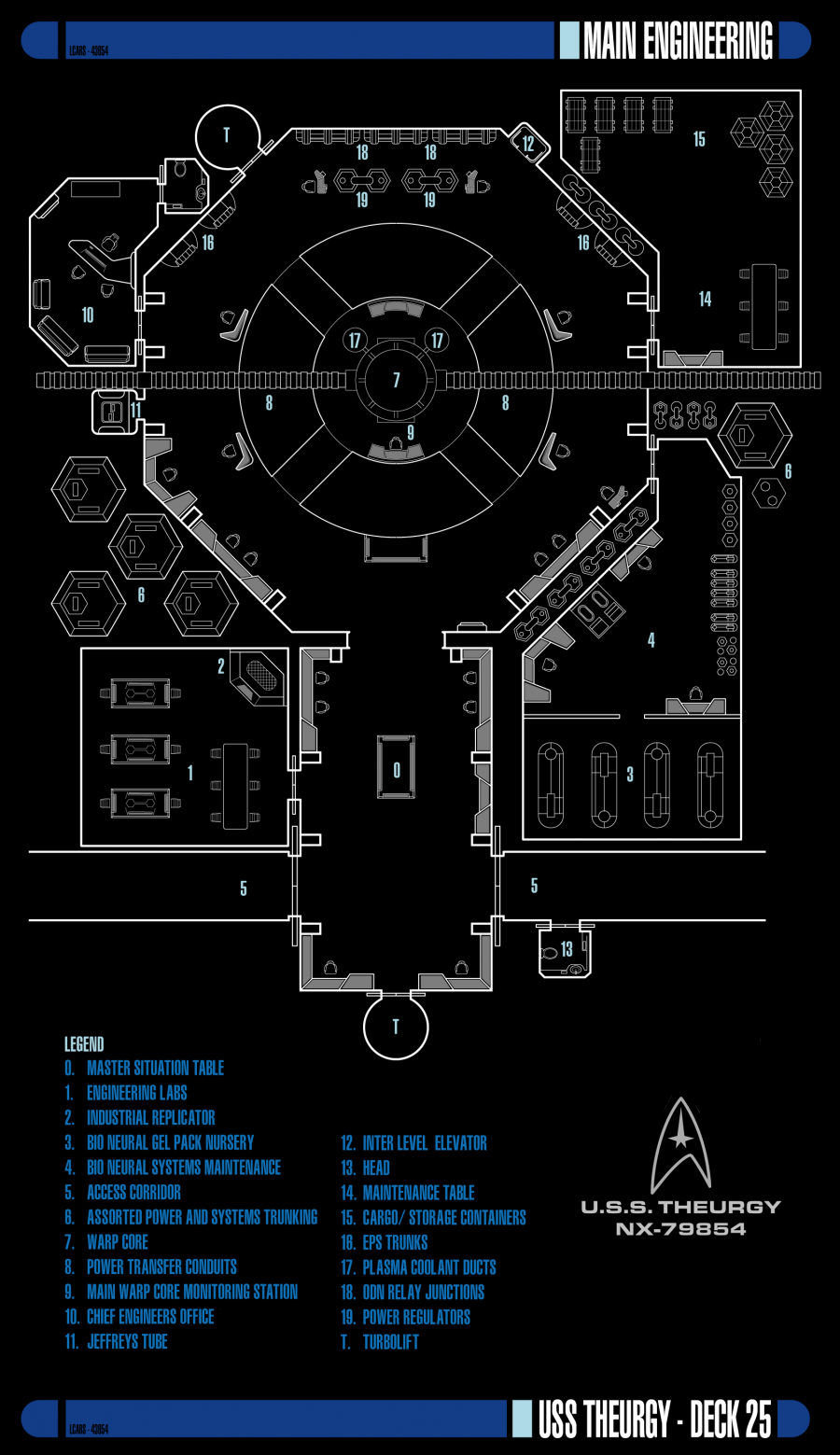
Full Resolution View at DeviantArt: http://auctor-lucan.deviantart.com/art/Main-Engineering-Deck-25-USS-Theurgy-NX-79854-680615597
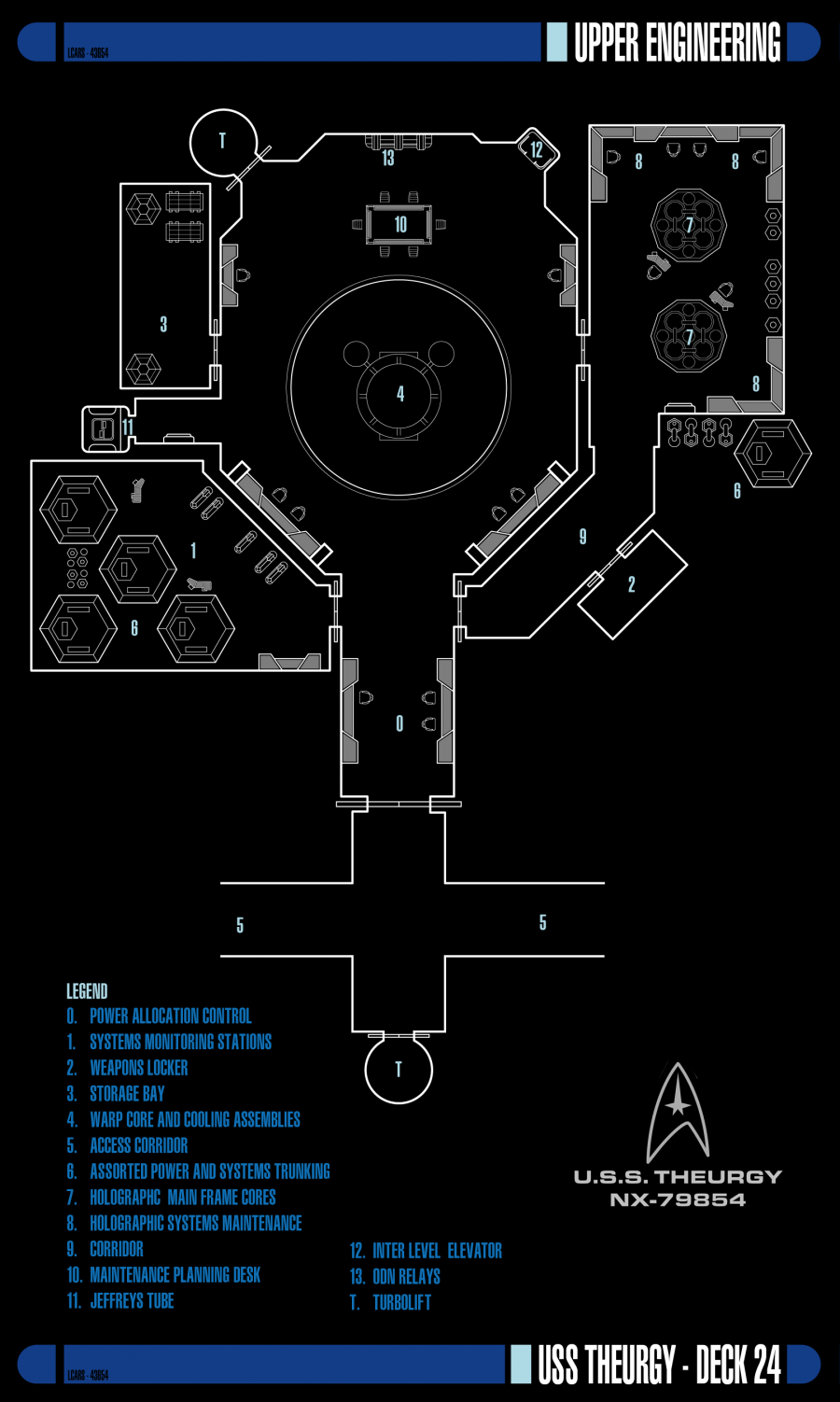
Full Resolution View at DeviantArt: http://auctor-lucan.deviantart.com/art/Upper-Engineering-Deck-24-USS-Theurgy-NX-79854-680616173
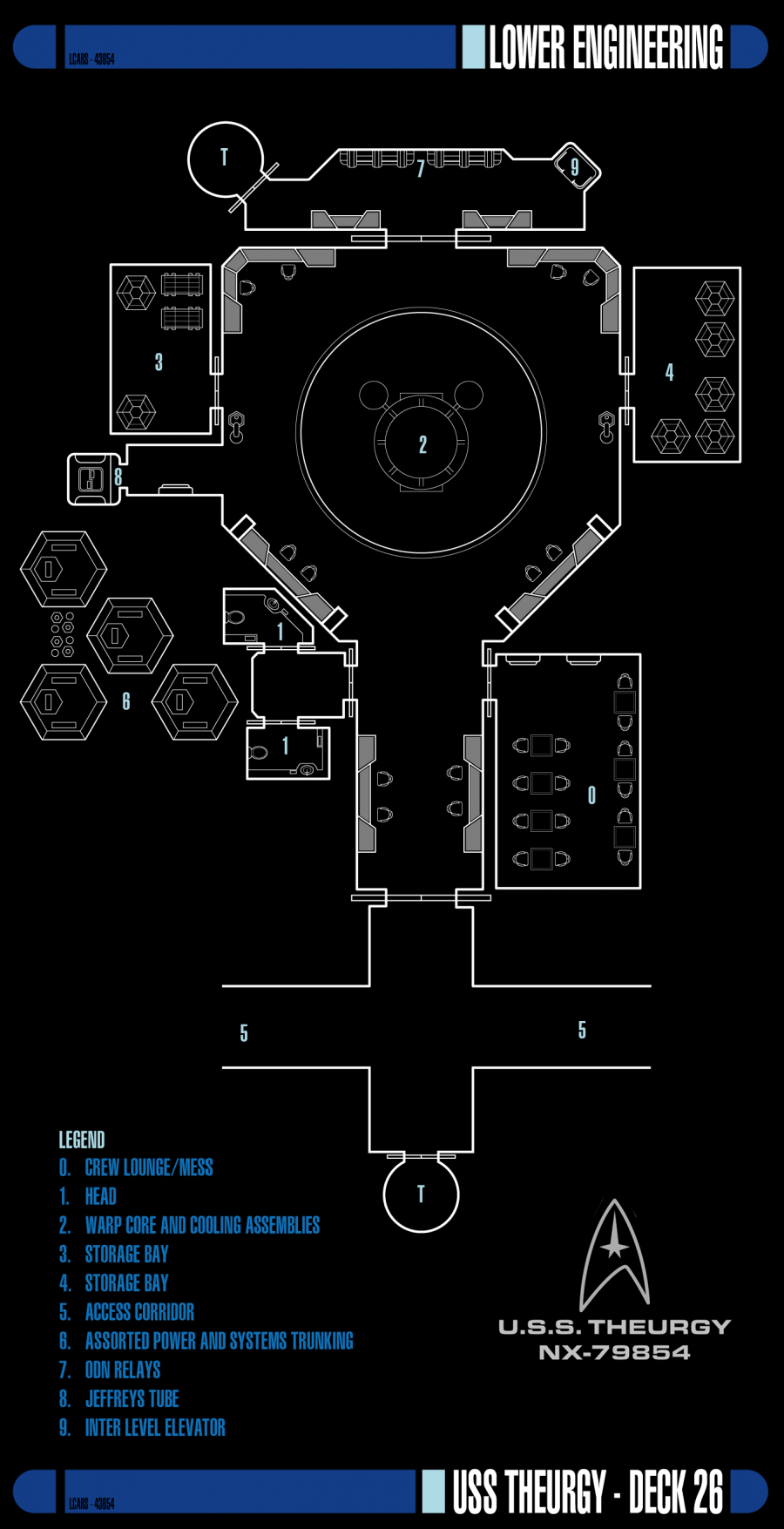
Full Resolution View at DeviantArt: http://auctor-lucan.deviantart.com/art/Lower-Engineering-Deck-26-USS-Theurgy-NX-79854-680616556
Auxiliary Engineering 01 & 02
The Theurgy had MVAM functionality, so this was one of the two auxiliary warp core areas, where the warp core was horizontal instead of vertical. The reaction chamber coukd be seen in the hole in the deck before the main console. Both auxiliary engineering areas were identical.
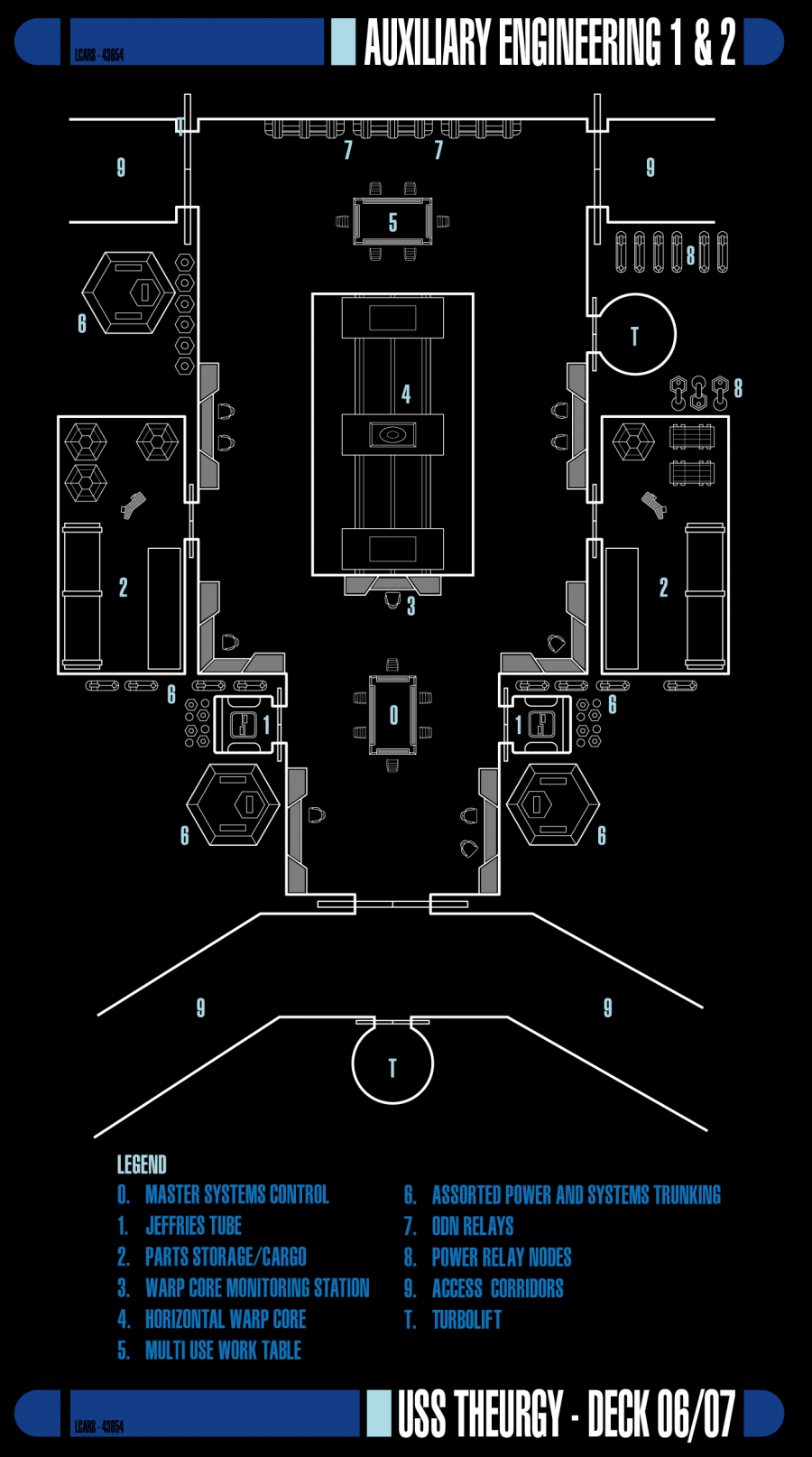
Full Resolution View at DeviantArt: http://auctor-lucan.deviantart.com/art/Auxiliary-Engineering-01-and-02-USS-Theurgy-680617026
Warp Core Ejection
In the event of a warp core breach, the Therugy-class starship could eject the warp core. This procedure required the authorization code of the chief engineer or a member of the senior staff. The core was ejected through the ejection port on the hull. Magnetic rails inside the channel accelerated the core once disengaged from the vessel and fired it away from the ship. Under normal circumstances, the vessel then moved away from the core as fast as possible under impulse power.
Should the core not go critical, the vessel could recover it with tractor beams and reintegrate it with careful manipulation.
Engneering Tools
A Starfleet engineer was expected to fix different systems and/or consoles aboard their starship or starbase. In order to do this, they needed different tools for the job.
Antigrav platform
The Antigrav platform was a Portable device used aboard Federation starships for handling cargo and other items too large for a single crew member to carry. It operated by means of a small anti-grav generator and a micro-fusion generator the platform, which stood at three meters long and a meter and a half wide. It was capable of carrying a load of up to 200kg, and as a result of the anti-grav system and the reduction in friction, this was able to be pushed easily by a single person.
Most starships carried a number of these, primarily used for moving parts and supplies between cargo holds and where they are needed.
Anyon Emitter
An anyon emitter was a device that used anyon particles to neutralize the effects of an interphase generator and chroniton fields. It operated by projecting a directed stream of particles when targeted at a specific location.
Anyon emitters were not often carried in large numbers aboard starships, because they were easily replicable and only needed in highly specific circumstances, usually to clean a hull of Chroniton particles. They were found in larger numbers aboard starbases, as they were needed to sweep every ship that came into dock to minimize the risk of a temporal incident occurring.
Bipolar Torch
The bi-polar torch was an advanced type of plasma cutting torch, it was the most advanced torch used by Starfleet. For the bi-polar torch to work it required filling two chambers with plasma, each oriented to a different polarity, the two were then mixed in the torch flame which created an extremely powerful cutting beam. Most starships only carried one or two of these, because they were highly expensive and highly complicated.
Cutter Beam
The Cutter Beam was a large hand-held tool that emitted a beam of directed energy which was used to perform a cutting function. It was, in essence, a simple phaser, which was designed to emit a short, but very powerful beam of phased energy. The power of the cutter beam decreased as its length was increased and its maximum length was one meter.
A common device, the cutter beam was a key part of most engineer's toolkits. It was also highly versatile, able to cut through any metal used on a Federation starship quickly and efficiently.
Cyrosensor
The Cryosensor was an Engineering tool that utilized sonic energy for component analysis. It used pulses of sonic energy to analyze the temperature of a power conduit which was in use. It was highly sensitive and capable of detecting even minute fluctuations in temperature. It was also much more sensitive than a standard tricorder and as such was used by Engineers and in monitoring systems on a starship.
Directional Sonic Generator
The Directional Sonic Generator was a tool which produced a directional beam of sound, with highly variable frequencies and amplitudes as well as having a variable projection field, from a millimeter wide to tens of meters wide able to interpret the returning sound waves. This was a tool which had a wide range of potential uses and could be found in anything from a standard set of speakers, to produce high quality sound. It could also be used as an engineering tool which could detect micro-fractures in metals, when tuned to its most sensitive. It could also be used for pest control and for security functions, as it could be tuned to produce high frequency sounds which debilitated most humanoids who are capable of hearing.
As such, the Directional Sonic Generator was one of the most common devices on a Federation starship and could be replicated with ease.
Duotronic Probe
The Duotronic Probe was an engineering tool used to regulate the plasma flow on a Starship. It operated by utilizing a basic duotronic computer to measure the quantity of plasma which passed through a location at a set period of time. It was a relatively precise tool, suitable for most flow regulation calculations. A more modern and precise form of this tool existed in the Gravitic Caliper.
Dynamic Stabilizer
A dynamic stabilizer was a device used to keep liquids and gases in certain containers from shifting, sloshing, or interacting with other materials, also stored inside. If the container was truly air- and/or liquid-tight, the stabilizer maintained a continuous forcefield so it didn't move around in its container. It used technology similar to a ship's Structural integrity field, and was widely used in transporting hazardous materials.
Emergency hand actuator
Emergency hand actuators were small devices used to open doors aboard Starfleet vessels in the event of power loss. They were stored at convenient locations near turbolifts, Jefferies tubes, and other vital areas. Use of the device involved attaching it to either side of the door which de-magnetized the counterweights, then pulling the door open.
Gravitic Caliper
More precise than a Duotronic Probe, this Engineering instrument was used to help regulate Plasma Flow. It operated by creating a localized gravitic field, which could be used to more accurately measure the flow rate of Plasma in a conduit. A couple of these devices were carried on a Federation vessel.
Hyperspanner
The hyperspanner was an invaluable tool for all Engineering and Operations Officers. While somewhat similar in both use and appearance to the magnetic probe, hyperspanners were both considerably safer and easier to use. This device monitored, calibrated, and adjusted the plasma flow in the plasma injectors used in the electroplasma systems (EPS). It also helped control the plasma flow inside the EPS conduits.
Since EPS systems were the primary power generation system on both starships and starbases, and served as an integral portion of all impulse drives, taking the EPS system completely offline for maintenance and repair was usually impractical unless a ship was berthed in a repair facility. Engineers most often used hyperspanners to regulate the EPS plasma flow without shutting down critical systems. They also rerouted the plasma flow around damaged components and precisely measured compression stresses in the plasma if the internal EPS monitors were damaged or offline. This device could also temporarily shut off small portions of the EPS flow without compromising the integrity or the function of the rest of the system.
Hyperspanners used a miniature array of polarized gravimetric projectors to create and direct several different sets of force fields. The unit's primary force field activated when its xynium-based sensors detected significant plasma density. This field protected both the unit and the user's arm from actually encountering the plasma. Failure of the primary field could result in severe plasma burns. The secondary force fields actually measured and manipulated the plasma flow. If the primary field failed, the secondary fields automatically compensated to provide protection for the device and its user while manipulating the plasma. Unfortunately, the secondary field could operate in this dual mode for approximately two minutes only.
Isolinear Chip Recorder
A tool that recorded Isolinear Optical Chips with data and software, used throughout Starfleet.
KLS Stabilizer
A KLS Stabilizer was a device used to maintain power output stability of a starships warp core.
Laser Torch
Laser torches were devices utilizing laser technology which allowed for easy cutting of materials. In the 24th century, Bajorans often used laser torches to cut wood, compared to the saber saw's they used in the past.
Maglock
An electromagnetic locking mechanism used to connect structural components together. Maglocks used on Federation ships typically employed both electronic and mechanical engage/disengage systems.
Magnaspanner
The magnaspanner was a handheld tool used by Starfleet engineers. No other info is provided.
Microdyne Coupler
A microdyne coupler was a device that could be used to delete information on a computer, leaving little or no trace.
Microoptic Drill
The microoptic drill was a handheld piece of equipment used to produce extremely small precision holes by Starfleet personnel and others.
Nanopolymer
A nanopolymer was a densified material that could be used to reinforce components of plasma flow conduits and was very important in engineering.
Neutrino Probe
A neutrino probe was a tool used to scan neutrino readings found in a Starship's warp signature. A standard Starfleet tricorder was not equipped to detect neutrinos.
ODN recoupler
An Optical Data Network recoupler was a tool used to connect OPN wiring together or to a OPN relay. It was also used to repair ODN lines.
Optic Cable
An optic cable was a fiber optic data transmission cable used aboard Federation starships.
Optronic Coupler
An optronic coupler was a tool used by Starfleet engineers for repairs of equipment.
Particle Emitter
Particle emitters were equipment used to project or release certain types of particles for use in specific kinds of energies. Examples used in Starfleet applications include:
- Phaser emitters - in modern times arrayed in banks along the hull and most often referred to as such, technically the part of the assembly from which the phaser beam started was the emitter on any phaser weapon, be it starship-size or handheld
- Holographic emitters, emitted both the photons and the force fields used to confine them to create the hologram, a special case was an Emergency Medical Hologram's mobile emitter, which was able to be fixed to its own projection (as evidenced by the Doctor wearing it)
- Navigational deflector - emitted the navigational shields that protected the ship from spaceborne debris (at normal impulse velocities, a fist-sized rock has enough kinetic energy to blow a hole the entire length of the starship, hence the need for deflectors), also may be reconfigured or jury-rigged to emit a vast variety of particle and energy beams and fields. The emitter was the deflector dish and the related assembly where the beams and fields were created.
- Shield emitters - these emitted the particles/energy required to create the shields around the ship. When they were damaged, parts of the ship or its entirety may be left unshielded.
Phase Compensator
A phase compensator was a tool used to calibrate or reset plasma manifolds and relays.
Plasma Infuser
A plasma infuser was a hand held engineering instrument used for the transfer of high energy plasma.
Plasma Torch
A plasma torch was a work tool used aboard Federation Starships and Space Stations.
Power Pack
A power storage unit that could be used to power devices of various kinds, from phasers to computers.
Self-ratcheting Coupling Clamp
A self-ratcheting coupling clamp was a tool used to install or repair couplings in a ship or station's Electro-plasma system (EPS). There were several sizes of the clamp and they were made of non-conductive materials and coated in a heat-resistant coatings.
Sonic Driver
The sonic driver was a hand held engineering device used to measure tetryon particle flux fields.
Subspace Field Sensor
A subspace field sensor was a hand held engineering device.
Superconducting Flux Degausser
A superconducting flux degausser was used throughout Federation starships to degauss Flux generators and Flux spectrometers. The process was done after the usage of either a Flux generator or a Flux spectrometer to eliminate residual magnetic fields. If a flux generator was activated without being degaussed it would at best provide incorrect results and at worst it could cause a cascading failure in the machine which could be damaging to personnel operating it as well as the ship itself.
Tetryon Analyzer
A tetryon analyzer was an engineering tool used specifically to track Tetryon particles, it was a little used tool that was usually used to locate localized tetryon emissions, in recent years it became a key part of weapons scanners to detect Tetryon based weaponry, as standard Starfleet sensors had extreme difficulty in scanning Tetryon particles.
Disclaimer Notice
- Starfleet Engineering Emblem used with permission of Gazomg Art - granted Nov 24, 2016
- Engineering tools info used with permission of USS Wolff CO - granted Jan 30, 2017
